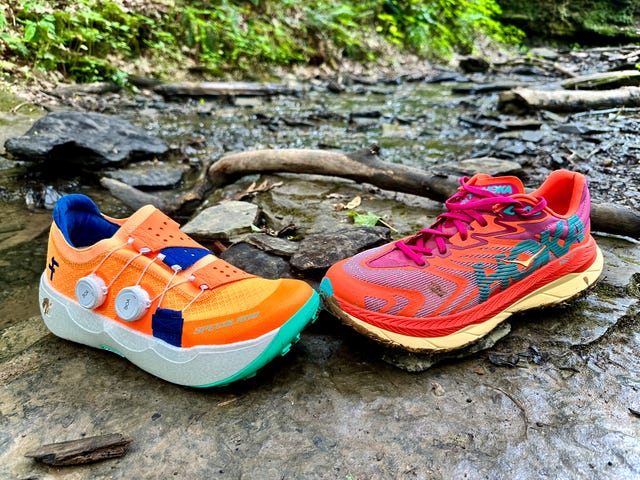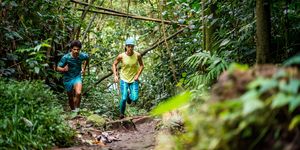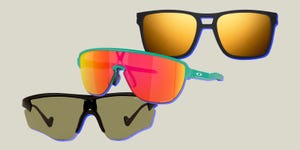Trail running shoes are the rugged cousins of your typical road running silhouettes. Boasting grippy outsoles and durable profiles designed for the muck and mud, these kicks can be excellent additions to any shoe rotation. Of course, though, those technical jaunts through the hills and valleys aren’t solely utilitarian — there’s room for some luxury and premium performance in those wild jogs through nature.
Premium trail running shoes can keep the twists and turns energetic, stable and downright fun. Two silhouettes that have held my attention as of late have been the GS:TAM from Speedland and Tecton X 2 from Hoka. With quality build components strewn throughout their respective profiles, it’s easy to see why these sneakers carry a higher price tag than other well-to-do silhouettes. Plus, both the GS:TAM and Tecton X 2 employ a carbon fiber plate system underfoot, which is a rarity along the trail (at least, rare to have the feature work efficiently). But if you’re avid about hitting the muck and mud in a luxe pair of shoes, which one do you choose? Which silhouette delivers enough fun and excitement to warrant a $200-pluss price tag?
To answer these questions and more, I strapped into each profile for multiple jaunts around my favorite local parks and trailways, highlighting each sneaker’s underfoot comfort and efficiency across varied terrain. While rain has been absent in recent forecasts, I was able to get both the GS:TAMs and Tecton X 2s in some mud and water, to test how these trail runners performed when conditions were less than ideal. Finally, I took some high-tempo jogs through some less-advanced trails to see how effective the carbon plates were at propelling my frame forward through the hills.
To learn more about our testing methodology and how we evaluate products, head here.
The Contenders for Best Premium Trail Running Shoe
Speedland GS:TAM
Like your favorite supercar, the Speedland GS:TAM is a wonder both visually and under the hood. The wide profile helps improve stability across rocks, roots and other obstacles, while the beaded Pebax external midsole gives each landing a plush sense of comfort without sacrificing a ton of ground feel. There’s also a good bit of breathability thanks to the updated mesh upper, which keeps things cool mid-training and also sheds water weight quickly if you encounter an errant puddle.
Other key features include a highly versatile BOA lacing system which takes full advantage of the dual-direction Li2 BOA dials, as well as the available drop-in Carbitex GearFlex plates. These carbon-fiber add-ons can help keep your strides springy and stable on faster days and can be easily removed for slower, more adventurous sessions where getting out is the main reward. The GS:TAMs aren’t compatible with third-party insoles, however, which limits their usability for those with lower arches.
Hoka Tecton X 2
When the original Tecton X debuted last year, it was an instant hit with trail runners everywhere, myself included. Thankfully, this second iteration only makes small adjustments to the silhouette, keeping the independent carbon plate design and impressive midsole while tweaking the profile here and there for improved performance in the wild. The Tecton X 2’s main revision comes in the form of an all-new Matryx fast-dry upper which boosts breathability while helping keep moisture at bay. Plus, at just 8.8 ounces, this is one of the lightest trail running sneakers available, making it an excellent pick for race day.
Of course, it’s difficult to talk about the Tecton X 2 without acknowledging the independent carbon fiber plates and Profly-X midsole construction. Forgiving upon landings and eager to throw you forward, this tandem makes every jaunt with these Hoka standouts a fun, energetic experience. Just be sure to choose a somewhat dry trail for your fast-paced workouts, though. The 4mm lugs are grippy on mild days, but any mud or wetter terrain can still leave you slipping and sliding.
Test 1: Fit and Lockdown
In terms of fit, both the GS:TAMs and Tecton X 2s provide ideal sensations for the twists and turns of trail running. The Tecton X 2 runs true to size with a lightweight composition that lends itself to the sneaker’s race day motives. The GS:TAMs, on the other hand, showcase a wider fit overall with snugness in key areas. In testing, the Speedland kicks provided a more natural foot shape across the build, which was most exhibited in the wider toe box for extra toe-splaying room. I will say, however, that the Tecton X 2s had a little more support along the medial side of the foot, which could be a better solution for athletes with low arches. When taking on hillsides with the Speedland options, I didn’t feel as much support, and the fact that the sneaker isn’t compatible with third party outsoles does indicate that this is an issue I’ll need to adapt to rather than fix.
When it comes to lockdown, however, the GS:TAMs are far and away the most secure trail running shoes I’ve paced in. This is attributed to the BOA PerformFit wrap across the upper and dual Li2 dials that work in both directions for finding that ideal upper sensation. I like to tighten my laces a bit when taking on more technical descents, which usually calls for a slight pause to readjust my laces. This time was cut in half as finding that tighter lockdown was just a few twists away with this impressive Speedland profile.
Test 2: Comfort and Traction
While both the Speedland and Hoka trail runners are surprisingly comfortable for varied mileage despite the carbon plate technology, I have to give the nod to the GS:TAMs given the shoe’s Pebax foam and unique plate setup. For days where I wasn’t trying to push my speed limits and just wanted a lowly stroll through the countryside, I was able to swap out the Carbitex GearFlex plates for a less responsive ride. The Tecton X 2s don’t feature this versatility, as the plates are baked into the Profly X midsole. Still, however, there is a drawback to this piecemeal design makeup from Speedland — the carbon plates are sold separately. While I fully recommend adding the $35 plates to your purchase order, it is an added cost worth pointing out.
I also found the outsole designs to be fairly similar in terms of traction and grip. Speedland’s Michelin Fiber Lite and Hoka’s Vibrams Megagrip technologies performed exceptionally well on dried pathways and somewhat loose terrain, but the lug depth was simply too short for muddy conditions. Hitting a few bogs led to some slipping and sliding at first, which definitely had me slowing my strides to get through the inclement conditions. I do feel these trail running sneakers are intended for summertime races, though, so it makes sense that the ultra-aggressive lug patterns aren’t seen in these silhouettes.
Test 3: Versatility
For short and long treks, it was hard to pick a favorite amongst these two impressive trail running silhouettes, but given the higher stack height and wider base, I’ll give the slight edge to Speedland in this testing category. I also appreciate the interchangeable plate design, which allows for less rigid landings and transitions when pacing doesn’t require a speed boost. While the GS:TAMs are a heavier profile overall — 10.9 oz. to 8.8 oz. — I didn’t feel this hindered pickups over extended mileage.
This isn’t to say, however, that the Tecton X 2s aren’t worthwhile for daily training or weekend sessions. I just feel the carbon plates and lightweight nature of the sneaker are more specialized for trail racing than the GS:TAMs. Add in the fact that you’re essentially getting two underfoot sensations in one with Speedland, provided you purchase the additional carbon plates, and it’s just to much to overcome. I still tend to favor my Tecton X 2s when there’s a lot of road-to-trail crossovers along my pathways, as it’s really enjoyable to let the carbon tech open up across this more stable platform and watch it seamlessly transition back into the dirt.
Best Overall Premium Trail Running Shoe: Speedland GS:TAM
With interchangeable plates, a fantastic BOA lacing system, comfortable underfoot feel and more, it’s difficult to ignore the Speedland GS:TAM if searching for a premium trail running shoe. I definitely look forward to taking these out more this summer and feel each mile only adds to the experience atop the beaded Pebax midsole. Plus, the silhouette is prime for a variety of trail runs, from the uptempo speed sessions to slower, high-mileage routes. If you want the best of the best and don’t mind paying for it, definitely keep these vibrant kicks on your radar this season.
Get the Speedland GS:TAM Here
Best Premium Trail Running Shoe for Race Day: Hoka Tecton X 2
If searching for that luxe silhouette ideal for trail racing, the Hoka Tecton X 2 is still a worthy contender. I’ve yet to find a carbon-plated trail running profile that works as efficiently as the Tecton stable, and the upgrades to the upper design answer plenty of pitfalls that plagued the original iteration. Plus, at a weight that rivals some marathon shoes, you’re sure to have plenty of juice in the tank when that mileage begins to tally up toward the finish line. Sure, the Tecton X 2s aren’t as versatile as other profiles, but do you really want to waste its potential with daily mileage or slower-paced routes? I didn’t think so.
Get the Hoka Tecton X 2 Here
SHOP NOW (HOKA) | SHOP NOW (REI) | SHOP NOW (BACKCOUNTRY)
How to Choose Which Trail Running Shoe is Right for You
The right trail running shoes begin with understanding your needs and wants when out in the open hills. Do you want a sneaker that’s lightweight and gives you plenty of ground feel for natural adjustments, or do you want to keep every step plush and cozy as you explore your local trailways? In the end, this decision comes down to your preferences and how you want to experience this unique running discipline day in and day out.
You should also consider your typical terrain when looking for trail running shoes. If you’re normally traversing flattened trails or paved walking paths, you can forgo the ultra-grippy, heavily lugged silhouettes designed for mud bogs and more technical terrain. While you’ll still want some tread to accentuate your silhouette — a least 3mm lugs should do — the less technical the trail, the less aggressive bite you’ll need. Think of purchasing trail running shoes and purchasing tires. Do you need those nubby all-terrain wheels for on-road mileage, and in the same sense, aren’t those smooth pavement-centric tires just asking for compromised traction through the muck and inclement conditions?
Finally, there are some boilerplate features to consider when looking for an ideal pair of trail running sneakers. Outside of the the grippy outsole, you’ll also want to look for a durable upper that can withstand some abuse from debris and inclement weather. Additionally, your trail running gait is likely to differ from your on-road stride to account for the different pitches in terrain, so look for a silhouette that has a somewhat rigid midsole construction. This can help keep your feet protected from jutting rocks and roots without having to alter your pace entirely to make it from A to B. Resilient foams can also be worthwhile, particularly for descents when your landings will be more aggressive to help combat gravity.






























